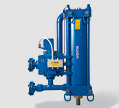
REPAIR SERVICES:
BLOG
RATES
ABOUT US
CONTACT US
INDUSTRIES SERVED
Servo Hydraulics Servo Hydraulics are fluid based systems which use electronic controls to manipulate hydraulic pumps and valves and use feedback devices to correct itself. Hydraulic systems are notoriously hard to control for extremely fine manipulations. Using electronic sensors and modern valve control systems they can be utilized to bring the strength of hydraulics to machinery that needs fine control oversight.
How servo hydraulic amplifiers work
The rotation of the pilot motor is converted into a linear movement of the spool within the NC-valve using the control thread on the control shaft. As the spool moves either the 'tank' or the 'pressure' ports are opened up. The flow of hydraulic medium is controlled into/out of both the piston area and piston ring area. 
|
Below are some Manufacturers of servo hydraulic systems. If you do not see yours listed, call us. We can still help you.
All Rights Reserved, REA Technologies, Inc. 2551 US Hwy 70, Connelly Springs, NC 28612 (828) 397-6050
The designated brand names and trademarks described on this website are the property of their respective owners.reatechtracking1


Over
83463
Items Repaired
Since 1991
Online Payments



